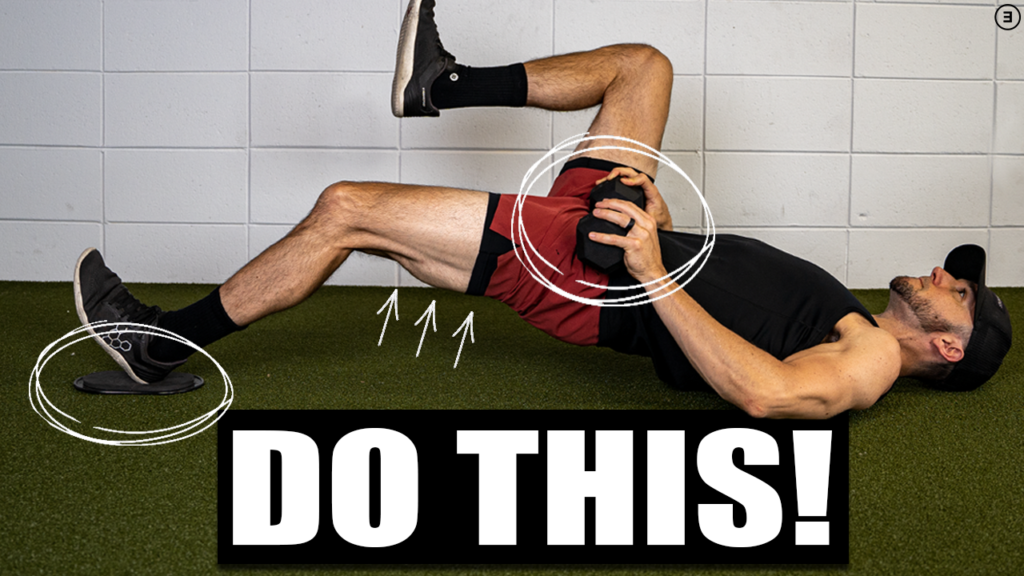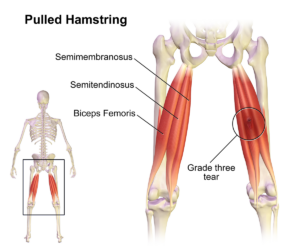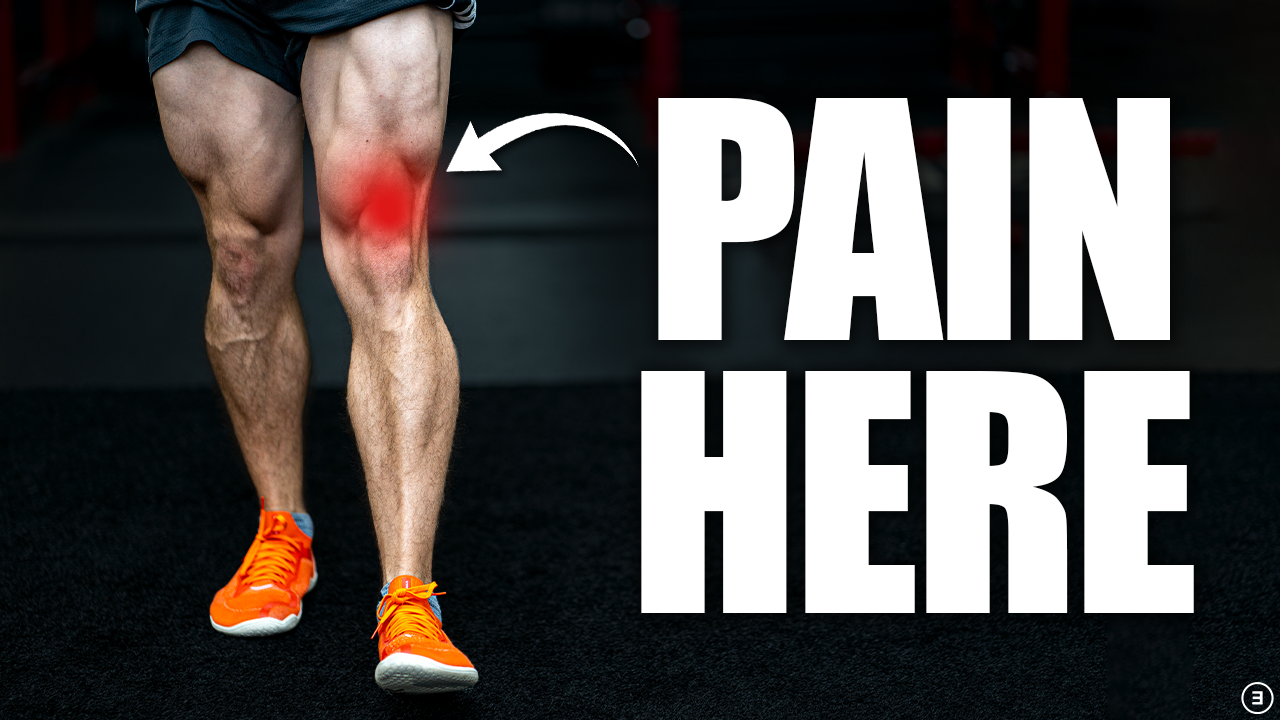The purpose of this blog is to discuss hamstring strain injuries, including the anatomy and function of the hamstrings, mechanism of injury, and provide a compressive rehab plan with exercise progressions, a running protocol, and criteria for returning to sport.
Looking for rehab or performance programs? Check out our store here!
Hamstring Anatomy, Function, and Mechanism of Injury
Hamstring strain injuries result in a sudden onset of pain in the back of the thigh, often causing an abrupt end to activity.
When you strain or pull your hamstring, it usually involves the long head of the biceps femoris, although it can also occur to one of the other two hamstring muscles – the semitendinosus or semimembranosus.
Since these muscles originate on your sit bone and insert onto your lower leg, they have actions at both the hip and the knee. Along with your glute max and adductor magnus, they contribute to hip extension, and are the primary muscles responsible for knee flexion.
A strain commonly occurs during movements involving forceful and extensive hamstring lengthening, such as during high speed running or kicking.
For example, if you watch this clip of Usain Bolt during his final race in 2017, as he swings his left leg forward, his hip is moving into flexion and his knee into extension – a position which lengthens the hamstring. It is at this moment – when his hamstring is rapidly lengthening – in which his injury occurs.
Hamstring Strain Rehab Overview
Following an injury, the goal of rehab is to address specific deficits seen in strength and muscle structure, as well as ultimately prepare you for the demands of high-speed running.
Your timeline from injury to return to sport can take anywhere from 1-6 weeks or longer. This is widely variable person to person, as it will depend on factors such as the severity of your injury and your sport or position.
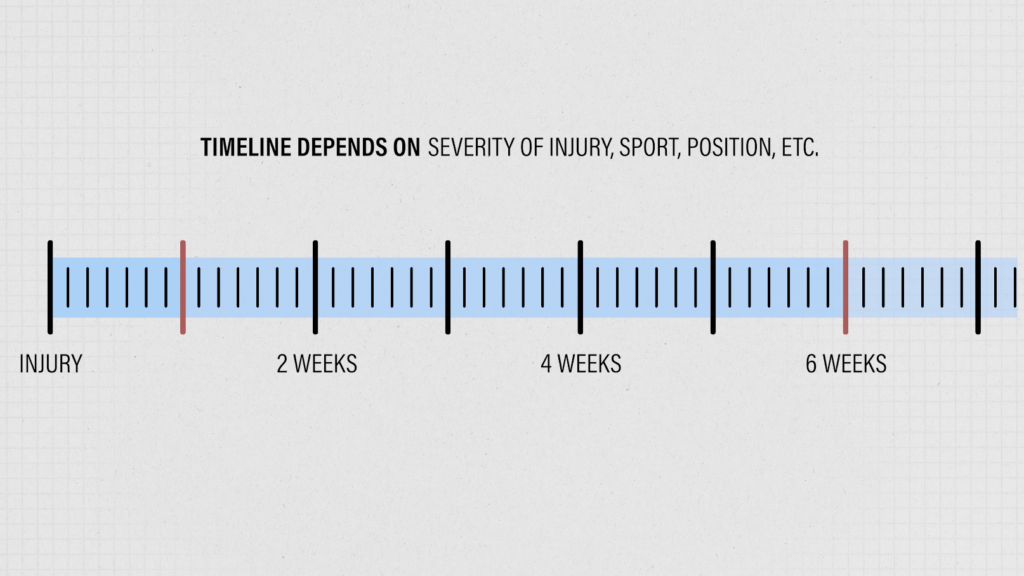
When can you begin rehab?
Immediately following an injury, you will likely rest from training for a few days as this allows time for acute symptoms to reduce before starting rehab.
When you should begin hamstring specific exercises is not exactly known, but most research shows that starting early – within about a week – “is safe,” and even has similar “return to sport times and reinjury rates compared to a delayed introduction” (Hickey et al. 2020, Askling et al. 2013, Askling et al. 2014, Mendiguchia et al. 2019).
Do you need to avoid pain during exercises?
There is also research showing that return to play timelines are similar whether you completely avoid pain or perform and progress exercises within a certain threshold – a pain rating of 4 or less out of 10. Utilizing this pain threshold can even result in “greater recovery of strength” and “better maintenance” of hamstring structure.
This means you can start exercises early and perform them either with or without pain. Either way, both have been shown to lead to similar results.
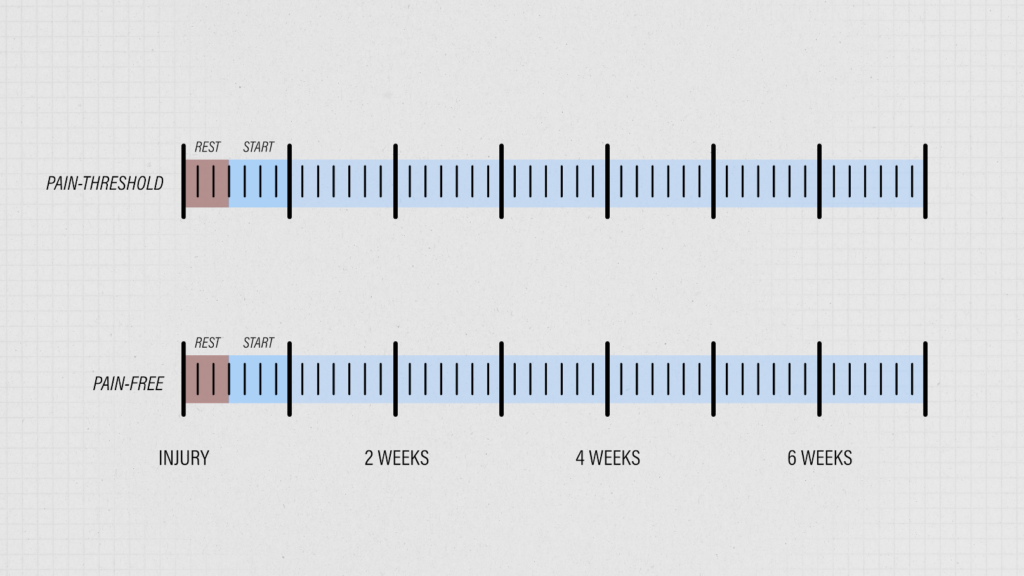
What exercises should you perform?
The main exercises will consist of hamstring specific strength and a progressive running protocol which you will perform simultaneously.
Based on the function of the hamstrings, mechanism of injury, and associated deficits following a hamstring strain, strengthening exercises will primarily emphasize 2 things:
- Eccentric knee flexor strength
- Hip extensor strength at moderate to long muscle lengths
Both of which will include double and single leg variations at a high intensity.
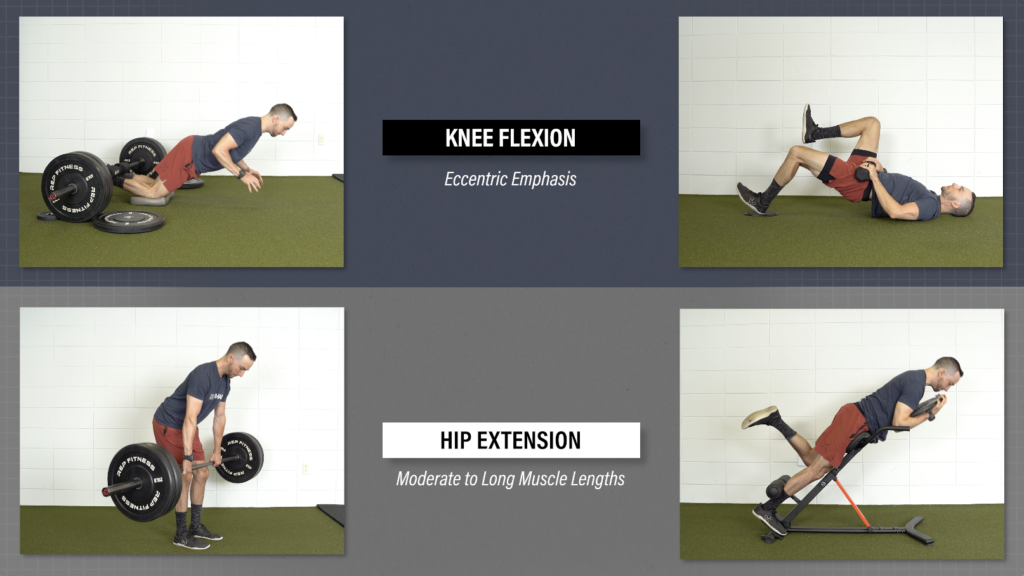
Each exercise category will have multiple levels of difficulty which you will progress based on performance and pain tolerance.
For example, if an exercise has 3 levels of difficulty, you will first start with level 1. Once you can complete a certain number of sets and reps through the full range of motion with a tolerable level of pain, you can progress to level 2. Then, to progress from level 2 to level 3, you must meet similar criteria.
The exercises will include progression criteria based on a pain threshold of 4 or less out of 10, but again, you can also perform these with less or no pain, and likely achieve similar outcomes.
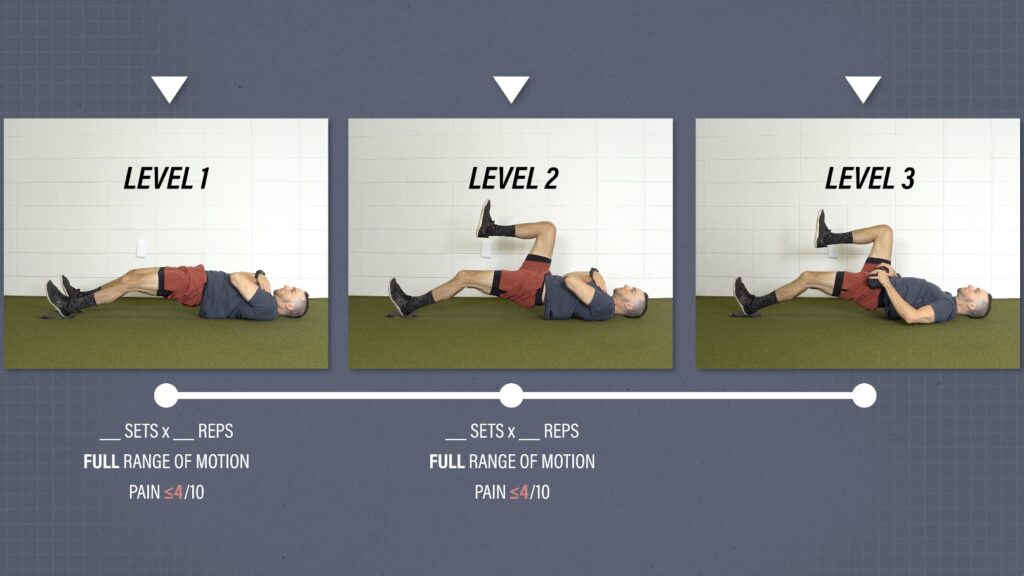
Hamstring Specific Exercises
Eccentric Knee Flexor Strength: Option 1
Level 1: Eccentric Sliders. With your feet on sliders, bridge up, and then slowly straighten your knees. Lower your hips down, bring your feet back to the start, and repeat. Once you meet the criteria shown, progress to level 2.
Level 2: Single Leg Eccentric Slider. Perform the same slow and controlled movement but this time on one leg.
Level 3: Weighted Single Leg Eccentric Slider. Similar to the previous exercise, but now place a weight on your hip. Perform for 3 sets of 4-6 reps on each side.
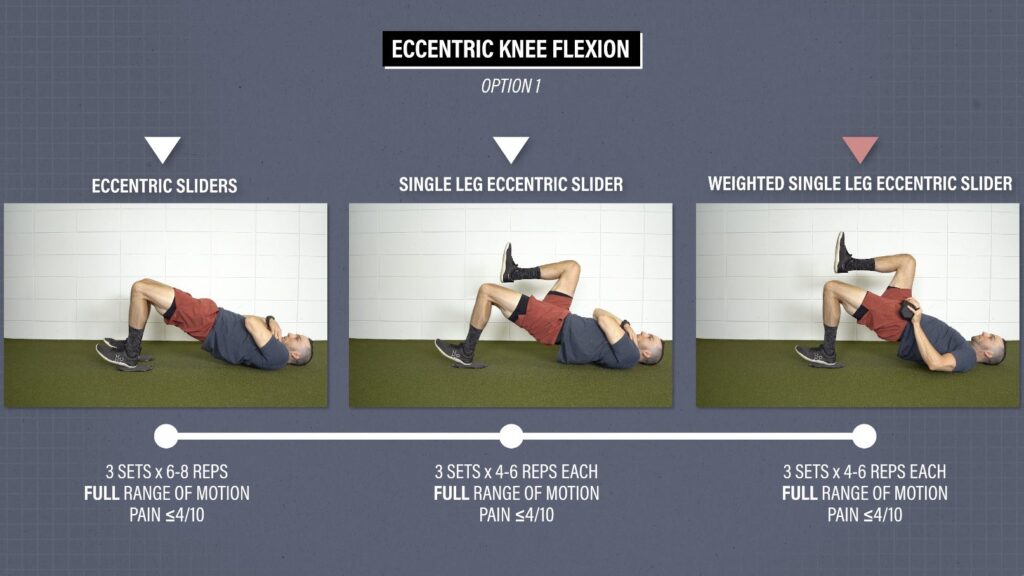
Eccentric Knee Flexor Strength: Option 2
Level 1: Eccentric Sliders. You will start with the same exercise as the previous option, but this time, once you meet the given criteria, you will progress to the Nordic Hamstring Exercise.
Level 2: Nordic Hamstring Exercise. Set up in a tall kneeling position with your knees on a pad and your feet secured. With your hips straight, slowly lower down using your hamstrings, trying to resist falling forward. Push yourself back up and repeat.
Level 3: Weighed Nordic Hamstring Exercise. Perform the same movement, but this time hold a plate or weight at your chest. To reduce the landing impact, place a pillow or pad underneath you. Perform for 3 sets of 4-6 reps.
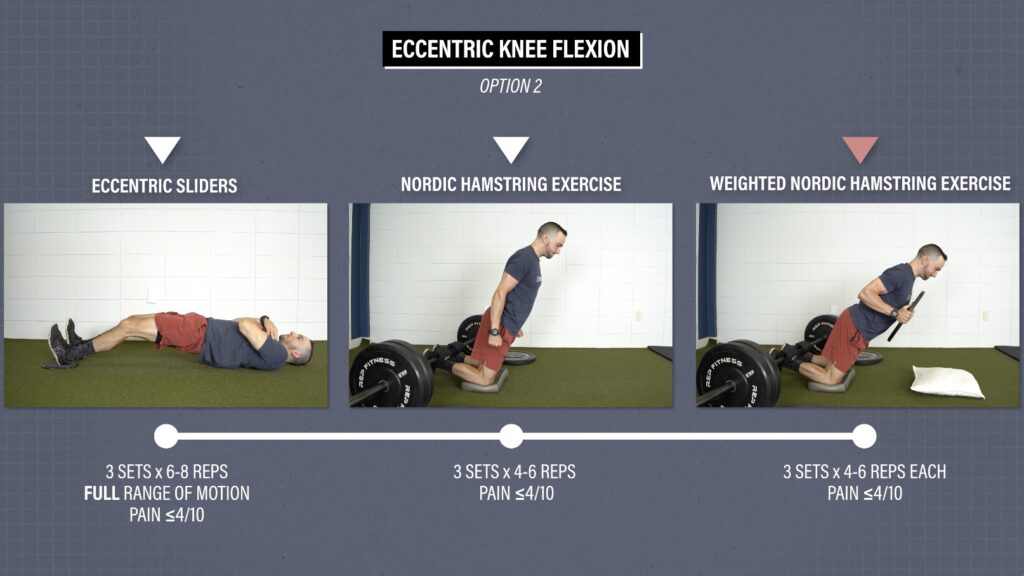
Hip Extension Strength: Option 1
Level 1: Bodyweight Single Leg RDL. With your knee slightly bent, hinge in your hips with a flat back and reach your arms forward, until your trunk is about parallel to the floor. As you lower, reach your other leg toward the ceiling. Once you meet the given criteria, progress to level 2.
Level 2: Weighted SL RDL. Hold a barbell, dumbbells, or another weight in your hands, and reach down toward the floor while keeping your back flat. Stand back up and repeat.
Level 3: Weighted RDL. By performing on two legs, your goal with this exercise is to progressively overload the hamstrings in a lengthened position. Perform for 3 sets of 6-8 challenging repetitions.
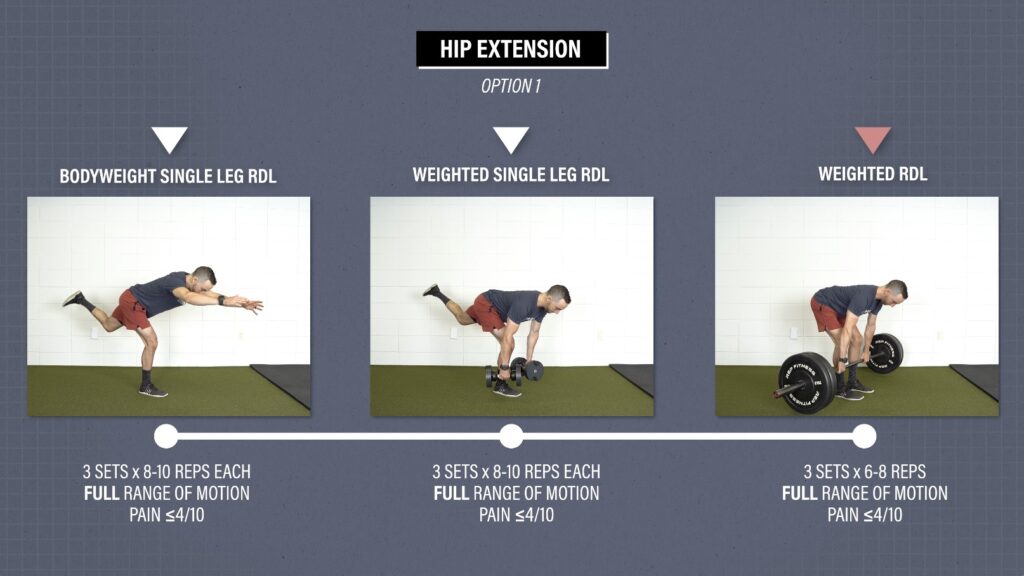
Hip Extension Strength: Option 2
Level 1: 45° Hip Extension. Using a roman chair or back extension machine, place your arms across your chest and hinge forward until you create about a 90° hip angle. Using your hamstrings, return back to the starting position where your shoulders, hips and ankles are in a straight line.
Level 2: Single Leg 45° Hip Extension. Same technique & execution, but now perform on one leg.
Level 3: Weighted Single Leg 45° HIp Extension. Perform the single leg hip extension while holding a weight across your chest. Move through your full hip range of motion for 3 sets of 6-8 reps on each side.

Hip Extension Strength: Option 3
If you don’t have access to the equipment necessary for option 2, here is a third hip extension option:
Level 1: Hamstring Bridge. Place both feet on a bench or elevated surface, with knees bent about 10 to 20°. Bridge up until your hips are straight, and then slowly lower back down. Once you can meet the given criteria, progress to Level 2.
Level 2: Eccentric Hamstring Bridge. Bridge up on two legs, and while keeping hips high, remove one leg, then slowly lower down. Repeat all reps on one leg before switching sides.
Level 3: Single Leg Hamstring Bridge. Keep one knee toward your chest, and bridge up and down through your full range of motion one one leg.
Level 4: Weighted Single Leg Hamstring Bridge. Place a weight on the working leg and perform 3 sets of 8-10 challenging reps on each side.
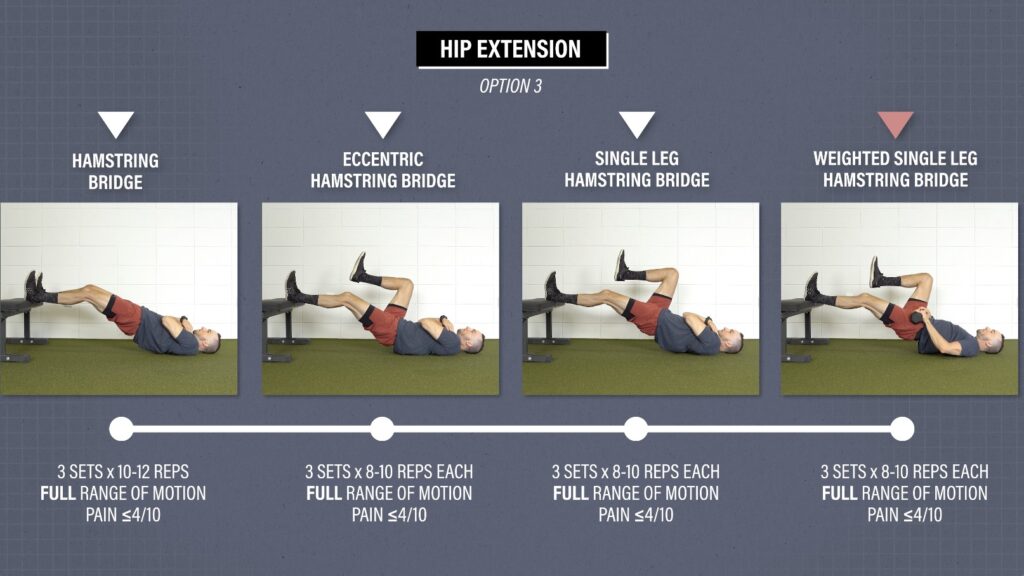
Optional Exercises
In addition to hamstring specific exercises, if you have time, optional exercises targeting the glutes, quads, and calves can be helpful since these are also heavily involved in running and sprinting.
Hip Thrust Progression
Level 1: Double Leg Hip Thrust.
Level 2: Single Leg Hip Thrust.
Level 3: High Velocity Single Leg Hip Thrust.
Level 3: Weighted Hip Thrust.

Split Squat Progression
Level 1: Heels Elevated Squat.
Level 2: Split Squat.
Level 3: Front Foot Elevated Split Squat.
Level 4: Weighted Front Foot Elevated Split Squat.

Heel Raise Progression
Level 1: Double Leg Heel Raise.
Level 2: Single Leg Heel Raise.
Level 3: Deficit Single Leg Heel Raise.
Level 4: Weighted Deficit Single Leg Heel Raise.
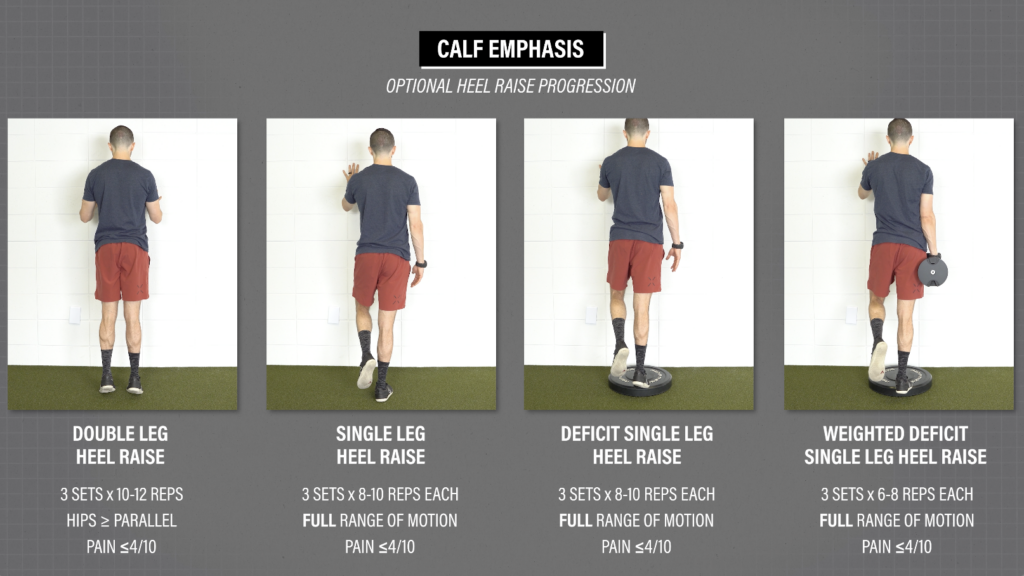
Optional Stretching
Another consideration is hamstring flexibility. This may not require direct intervention as range of motion deficits will likely recover on their own or with the previous exercises. However, if deficits persist or if you simply find that these feel good, here are 2 options:
Option 1: Active Knee Extension. Hold the back of your thigh with your hip flexed to about 90°, and then slowly straighten your knee as far as comfortable. Perform for 3 sets of 12 repetitions, 2-3x/day, while following the same pain parameters as before.
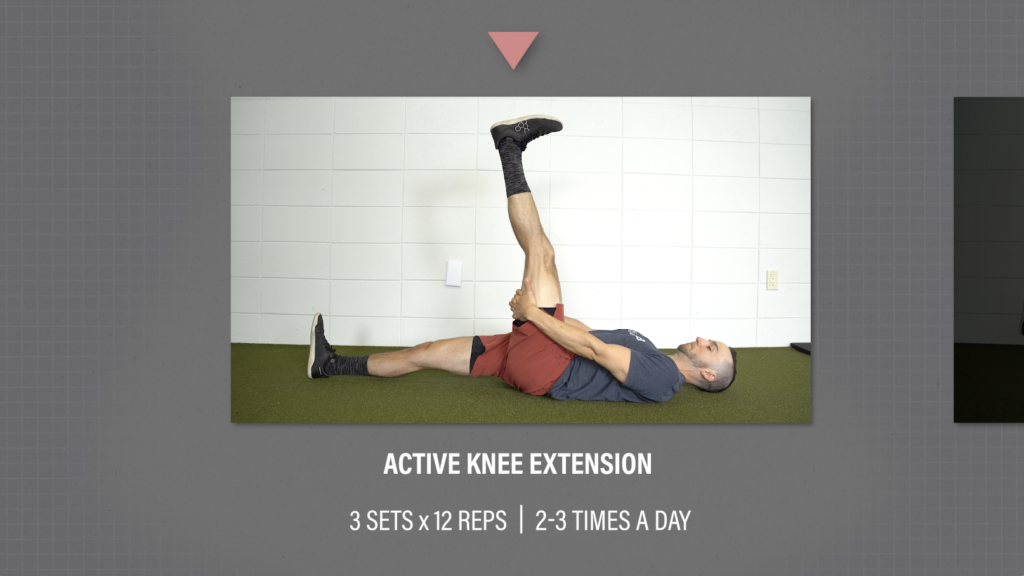
Option 2: Active Straight Leg Raise. Place a strap or towel around your foot and lift your leg up, until you feel a mild to moderate hamstring stretch. While keeping both knees straight, actively lift and lower your other leg for 3 sets of 12 repetitions. Perform on both legs, 2-3x/day.
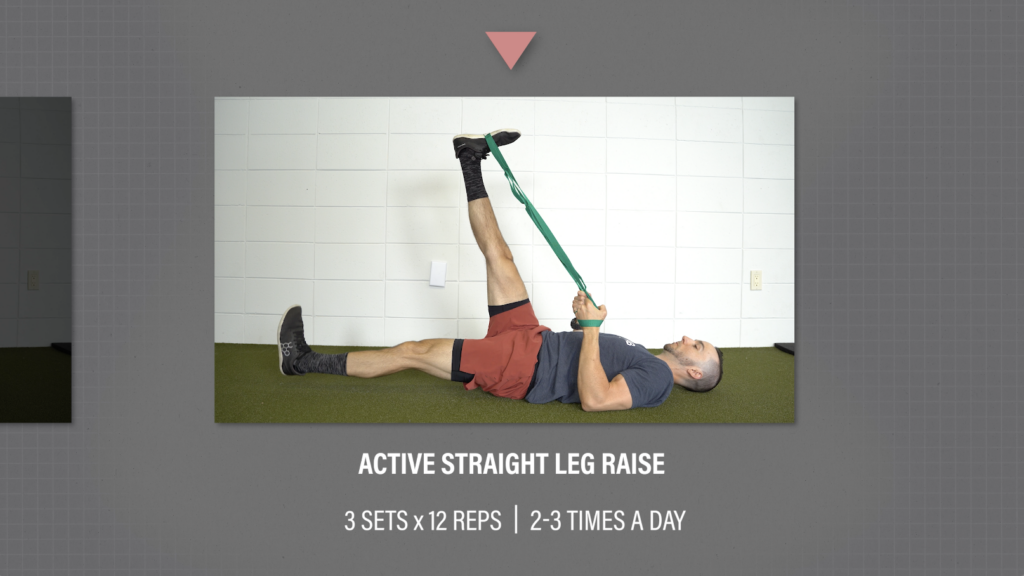
Exercise Programming
You should perform the hamstring exercises 2-3 times a week, progressing through the levels based on performance and pain tolerance.
If time allows, you can consider adding additional exercises targeting the glutes, quads, and calves, but the hamstring exercises should take priority. You can also perform optional stretches to improve your hamstring range of motion, if needed.
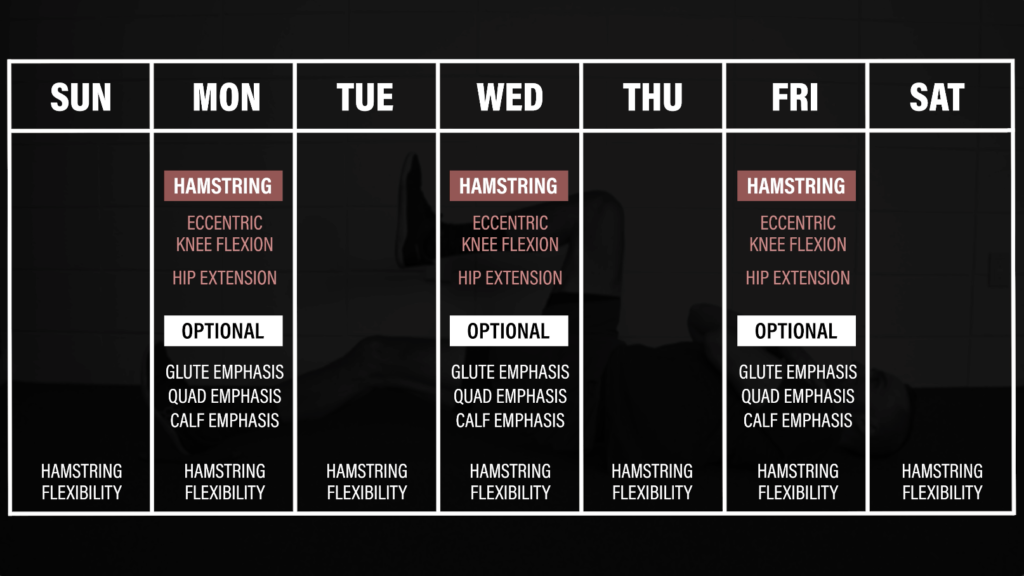
Running Protocol
The second component of rehab is a progressive running protocol. As stated in a 2022 paper, it is “arguably the most important aspect of rehab” since it’s “fundamental to performance in many sports” and is a “common mechanism of injury.”
These authors also outline a 3-stage protocol with gradual increases in running intensity that you can use as a guideline.
After you can walk with a pain rating 4 or less out of 10 , you can start stage 1.
Stage 1: Jog slowly for 20 meters (up to ~25% max speed), then increase your speed up to 50% of your maximal velocity for 60 meters, then return back to a slow jog (~25% max speed) for 20 meters. Once you can complete 3 repetitions at 50% of your maximal speed with minimal pain (≤4/10), progress to stage 2.
Stage 2: Slowly ramp up to moderate-speed for 30 meters, then increase to high-speed running (up to 80% of your maximal velocity) for 50 meters, before slowing back down again. Once you can complete 3 repetitions at 80% without pain (0/10), progress to the final stage.
Stage 3: You will perform shorter sprint distances at a higher intensity. Your goal is to gradually increase your running speed in 5% increments, until you are able to safely build up to 100% effort sprints without pain.
Exercise and Running Programming
Ideally, you will perform the running protocol 2-3 days/week on the days you do not complete the strength exercises. If you have to perform them on the same day, complete the running first so sprinting is not compromised by fatigue or soreness.
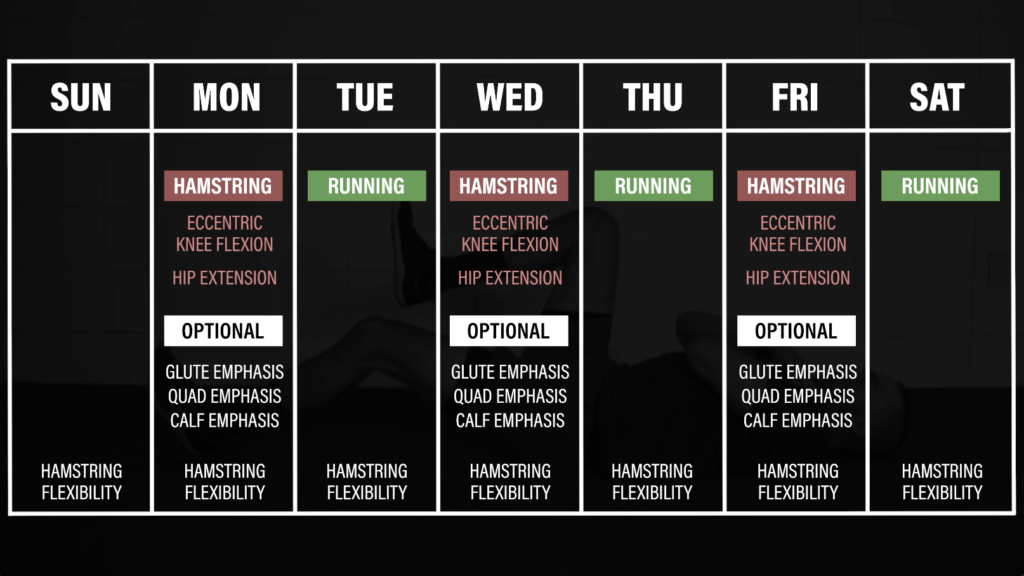
Return to Sport
Generally, the “research to support return to sport decisions is scarce”, likely because this process is “complex and multifactorial.”
But there is consensus on some criteria that must be met prior to returning to play. Even though these are specific to soccer, they will have carryover to other sports as well.
The main criteria includes:
- The absence of pain on palpation and during strength and flexibility testing.
- Hamstring flexibility within 90% of the other side.
- Psychological readiness.
- The ability to perform various tests at 100% effort without pain during or after.
Possessing similar eccentric hamstring strength side-to-side is a potential criterion, but, at this moment, not essential for reducing risk of reinjury.
However, because it is “associated with sprinting acceleration mechanics”, maximizing eccentric hamstring strength should still be a “desirable rehab outcome for sports performance”.
Also, you should continue to perform these exercises even after you return to sport in order to “avoid regression of the positive changes in hamstring muscle structure.”
And finally, it is important to understand that even when you return back to your sport, it might not be at 100% of your desired level. This will still take time until you can gradually build back up to performing at preinjury level or higher.
Summary
From the moment you sustain a hamstring strain, to the day you return to sport, can take anywhere from 1 to 6 weeks or longer depending on the severity of injury, sport position, goals, etcetera.
There might be a slight advantage to starting rehab exercises early and performing them within a certain pain threshold, since this has been shown to be “safe and may allow earlier exposure to and progression of beneficial stimuli.”
Regardless, rehab should focus on hamstring specific strength and a progressive running protocol, both of which can be performed simultaneously on alternating days, 2-3x/week. If you have time, you can also implement other strength exercises, as well as flexibility drills, if needed.
Looking for rehab or performance programs? Check out our store here!
Want to learn more? Check out some of our other similar blogs:
Thanks for reading. Check out the video and please leave any questions or comments below.


